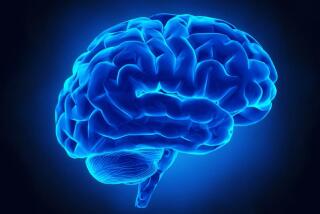As Man Lay in Coma-Like State, His Brain Was Busy Rebuilding
- Share via
Terry Wallis awoke from a coma-like state 19 years after tumbling over a guardrail in a Chevy pickup and falling 25 feet into a dry Ozarks riverbed. Now doctors armed with some of the latest brain-imaging technology think they may know part of the reason.
Although Wallis had showed few outward signs of consciousness, his brain had been methodically rebuilding the white-matter infrastructure necessary for him to interact with the outside world, researchers reported Monday in the Journal of Clinical Investigation.
“I believe it’s a very, very slow self-healing process of the brain,” said lead author Henning Voss, a physicist at Cornell University’s Weill Medical College Citigroup Biomedical Imaging Center in New York.
Wallis emerged in 2003 from a minimally conscious state at the age of 39 and uttered his first word since Ronald Reagan had been in the White House: “Mom.” Since then, the onetime mechanic from Big Flat, Ark., has regained the ability to form sentences and has recovered some use of his limbs, though he still can’t walk or feed himself.
Using PET scans and an advanced imaging technique called diffusion tensor imaging, the researchers examined Wallis’ brain after he regained full consciousness. They found that cells in relatively undamaged areas had formed new axons, the long nerve fibers that transmit messages between neurons.
“In essence, Terry’s brain may have been seeking out new pathways to reestablish functional connections to areas involved in speech and motor control to compensate for those lost due to damage,” said the study’s senior author, Dr. Nicholas Schiff, a neurologist at the Weill Medical College.
Schiff cautioned that Wallis was a “1-in-300-million” case. But Dr. Steven Laureys, a neurologist at the University of Liege in Belgium, said the findings will force doctors to reconsider the way they treat patients who are languishing in minimally conscious and persistent vegetative states.
“It does show there are changes happening” in the brain, said Laureys, who coauthored a commentary that also appears in the journal. “It obliges us to reconsider old dogmas.”
In a minimally conscious state, a patient shows intermittent signs of awareness but is generally unable to interact with the outside world. It is a less severe condition than a persistent vegetative state, in which the patient is awake but has no awareness of self or surroundings.
The late Terri Schiavo, the Florida woman at the center of a bitter right-to-die battle, had been in a persistent vegetative state for 15 years when her husband won a court order to have her feeding tube removed last year.
Neurologists believe that the longer a patient remains in a minimally conscious or persistent vegetative state, the lower the chances for recovery. As a result, such patients are often neglected by doctors and insurance companies, and it can be difficult for family members to find facilities that will accept them, Laureys said.
In his last few years at the Stone County Nursing and Rehabilitation Center in Mountain View, Ark., Wallis’ family began to notice that Wallis, a Ford enthusiast, would grunt when a Chevrolet commercial came on the television. They said he answered questions by blinking. About two years before he regained full consciousness, doctors started administering the antidepressant Paxil, which they think may have contributed to his recovery.
Within a week of his first utterance, Wallis began speaking in simple sentences. Once paralyzed from the neck down, he can now point with his left hand and move both legs.
The researchers scanned Wallis’ brain eight months after his awakening and found strong evidence that axons were making new connections in the cerebellum, the region that controls movement. The activity, which was stronger than in the brains of 20 healthy people scanned for comparison, seemed to correlate with Wallis’ physical improvement, Voss said.
When his brain was rescanned 18 months later, signs of growth in the cerebellum had leveled off and other areas of the brain were using more energy.
Wallis’ language skills improved during that time -- he learned to count to 25 without interruption, and his speech became more intelligible. But when the researchers looked for evidence of increased activity in the language centers of his brain, they found none.
“Maybe we just missed it, or maybe the language areas are unusable because important connections are missing,” said Voss, who theorizes that another part of the brain picked up the slack.
Voss and his colleagues also scanned the brain of a car accident victim who is still minimally conscious and found significant axonal regrowth as well. That patient, however, has not shown corresponding clinical improvement, according to the study.
“We have to understand this much better to know how to promote healing in other patients,” Voss said.
“We’re still a long way from therapies.”







